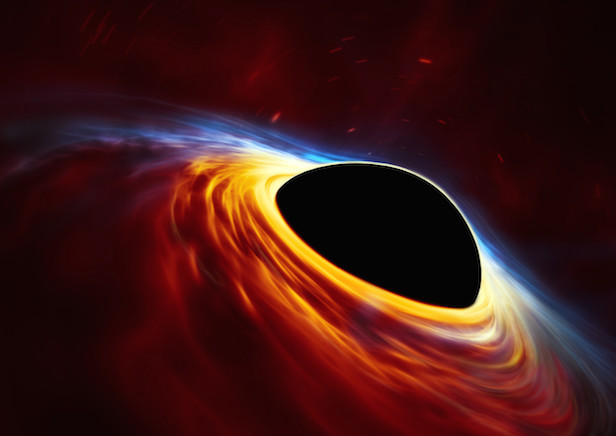How a water tank can be used to simulate a black hole
Black holes and water tanks exhibit the similarities in their wave propagation, providing a useful Earth-based insight

Some aspects of a black hole cannot be directly observed, so astronomers rely on equivalent Earth-based experiments. Image credit: ESO, ESA/Hubble, M. Kornmesser
Certain phenomena that occur in black holes but cannot be directly observed in astronomic investigations can be studied by means of a laboratory simulation. This is possible due to a peculiar analogy between processes that are characteristic of black holes and hydrodynamic processes. The common denominator is the similarity of wave propagation in both cases.
This possibility is explored in a new article published in Physical Review Letters. Physicist Maurício Richartz, a professor at the Federal University of the ABC (UFABC) in Brazil, is one of the authors of the article, produced by Silke Weinfurtner’s group at the University of Nottingham’s School of Mathematical Sciences in the United Kingdom. The research was supported by FAPESP via the Thematic Project “Physics and geometry of spacetime”, for which Alberto Vazquez Saa is the principal investigator.
“While this study is entirely theoretical, we’ve also performed experimental simulations at Weinfurtner’s lab,” says Richartz. “The apparatus consists basically of a large water tank measuring three metres (10 feet) by 1.5 metre (five feet). The water flows out through a central drain and is pumped back in, so that the system reaches a point of equilibrium in which the quantity of inflow is equal to the quantity of outflow. We simulate a black hole in this way.”
Richartz provided further details to explain how this was done. “The water flow speeds up as it approaches the drain. When we produce waves on the surface of the water, we obtain two important velocities: the velocity of wave propagation and the velocity of the overall water flow,” he says.
“Far from the drain, wave velocity is much higher than fluid velocity, so waves can propagate in any direction. The situation is different near the drain, however. Fluid velocity is much higher than wave velocity, so the waves are dragged down by the water flow even when they’re propagating in the opposite direction. This is how a black hole can be simulated in the lab.”

The artist’s concept depicts a supermassive black hole at the centre of a galaxy. The blue colour here represents radiation pouring out from material very close to the black hole. Image credit: NASA/JPL-Caltech
In a real astrophysical black hole, its gravitational attraction captures matter and prevents waves of any kind from escaping, including light waves. In the hydrodynamic simulacrum, the waves on the surface of the fluid cannot escape from the vortex that forms.
In 1981, Canadian physicist William Unruh discovered that the similarity between the two processes – a black hole and a hydrodynamic simulacrum – was more than a mere analogy. With a few simplifications, the equations that describe the propagation of a wave in the vicinity of a black hole are identical to those that describe the propagation of a wave in water flowing down a drain.
This legitimises the use of hydrodynamic processes to investigate the phenomena typical of black holes. In the new study, Richartz and collaborators analysed the relaxation (ring-down) process in a hydrodynamic simulacrum of an out-of-equilibrium black hole, taking previously ignored factors into account. In some respects, the phenomenon they studied is similar to the ring-down process in an actual astrophysical black hole that generates gravitational waves after being created by a collision with two other black holes.
“A careful analysis of the ring-down spectrum reveals the properties of the black hole, such as its angular momentum and mass. In more complex gravitational systems, the spectrum might depend on more parameters”, the authors write in the article published in Physical Review Letters.
Keep up to date with the latest news in All About Space – available every month for just £4.99. Alternatively you can subscribe here for a fraction of the price!




